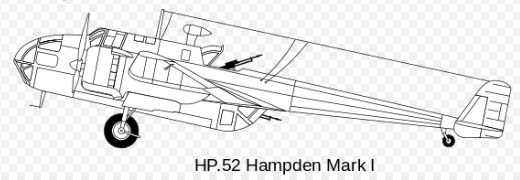I don’t recall what thread I was in, but a FineScale discussion board member recently recommended a product called EZ Line for aircraft aerials. I bought some, and installed my first antenna just last night. All it took was a .5 mm drill bit to drill holes in the vertical stabilizers of my Airfix HP.52 Hampden model, some white glue to stiffen one end of a piece of EZ Line, and some crazy glue. In less than 10 minutes I had installed one aerial, and it looks great! Tonight, the next ones. Thanks to whomever it was for the recommendation. But the installation of the aerial raised a question.
The Hampden’s armament include twin Browning machine guns in it’s dorsal turret, pointing towards the tail of the aircraft. The aerials had to have been right in the arc of the machine guns as they traverse. Here’s an image, courtesy of Wikipedia:

The Hampden had a reputation for being a very dangerous airplane. Its poor armament (.303 Browning machine guns) and lack of armour made it a sitting duck for German fighters. It had a nasty habit of side-slipping in low speed turns, and the narrow cockpit, designed just for one pilot, made death for the crew almost certain if the pilot were seriously wounded or killed. A damaged aerial probably wouldn’t result in a crash, but Hampden crews depended heavily on radio signals for navigation. So how in heck would Hampden dorsal gunners avoid severing the aerials when they were trying to shoot down German fighters?
Bob
On the bench: A diorama to illustrate the crash of a Beech T-34B Mentor which I survived in 1962 (I'm using Minicraft's 1/48 model of the Mentor), and a Pegasus model of the submarine Nautilus of 20,000 Leagues Under the Seas fame.